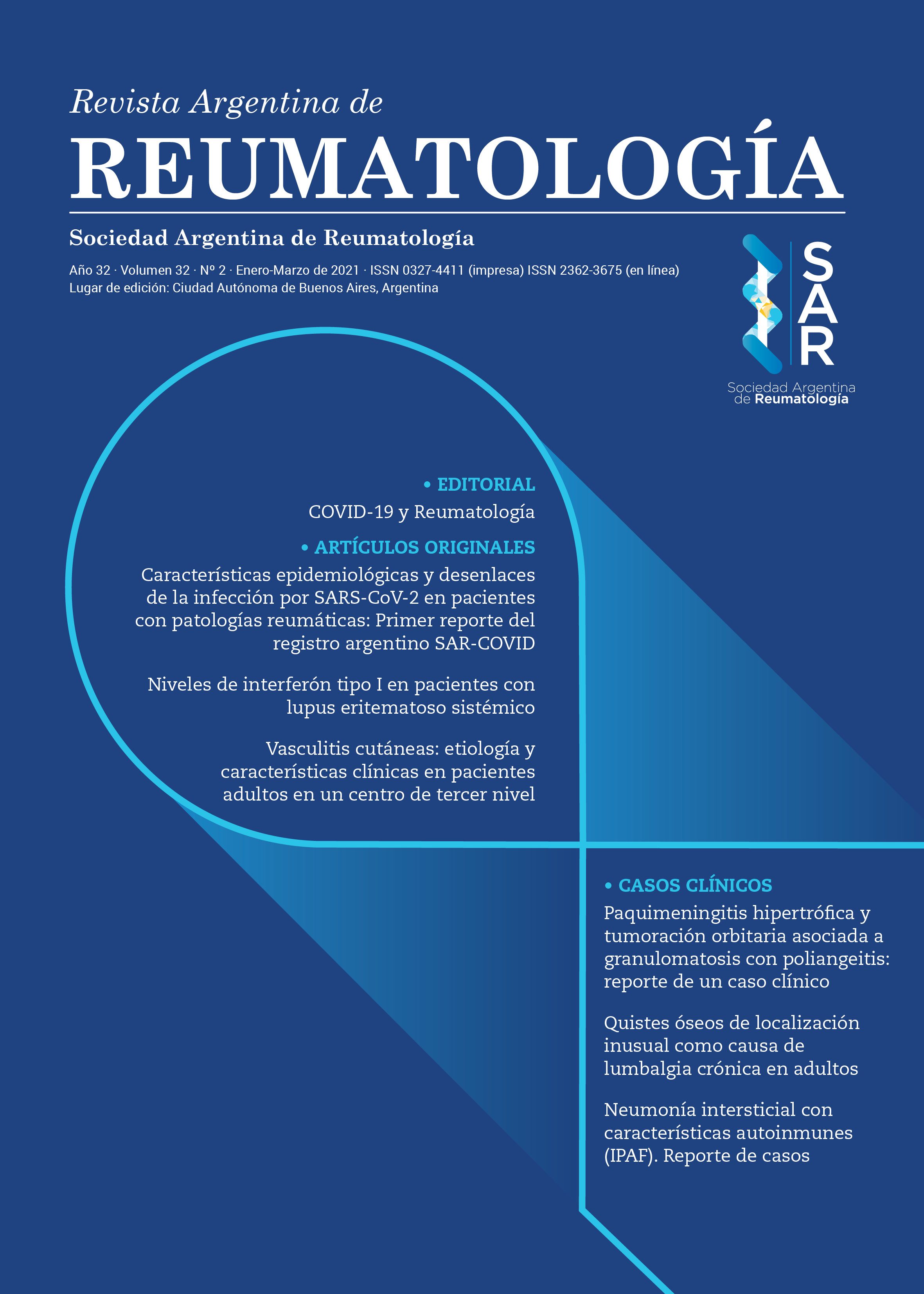Persistencia a largo plazo de agentes biológicos en el tratamiento de pacientes con Artritis Reumatoidea: una revisión sistemática de la literatura
Resumen
La persistencia en el tratamiento es un marcador subrogante de éxito de tratamiento a largo plazo. Objetivo: evaluar la persistencia de los agentes biológicos utilizados para el tratamiento de pacientes con artritis reumatoidea (AR) a un tiempo de 5 años y determinar las principales causas asociadas a persistencia o discontinuación. Material y métodos: se realizó una revisión sistemática de la literatura (RSL), según las recomendaciones PRISMA, en las bases de datos Pubmed, Cochrane y Lilacs, y estudios presentados en los congresos ACR, EULAR, PANLAR (2018/2019) hasta enero 2020. Dos revisoras independientes, evaluaron todas las publicaciones identificadas, por título y abstract y por full text, de acuerdo a la metodología PICO. Los criterios de elegibilidad fueron estudios de pacientes ≥ 18 años con diagnóstico de AR, en tratamiento con agentes biológicos, que midieran persistencia/discontinuación en un período de tiempo igual o superior a 5 años y que estuvieran en idioma inglés o español. En el caso de falta de acuerdo entre las dos revisoras, un tercer revisor fue consultado. La información extraída fue analizada mediante estadística descriptiva, se calculó el porcentaje promedio de persistencia de cada agente biológico a los 5 años.Citas
I. Citera G, Maldonado Cocco J A. Evolución y Pronóstico de la Artritis Reumatoidea, Capítulo 19, pp 250-3. Reumatología. Buenos Aires. Ediciones Azzurras. 2010.
II. Pincus T, Callahan LF. What is the natural history of rheumatoid arthritis? Rheum Dis Clin North Am. 1993;19(1):128-51.
III. Sokka T, Kautiainen H, Hannonen P, Pincus T, et al. Changes in Health Assessment Questionnaire disability scores over five years in patients with rheumatoid arthritis compared with the general population. Arthritis Rheum. 2006;54(10):3113-8.
IV. Schneeberger EE, Citera G, Maldonado Cocco JA, Salcedo M, Chiardola F, Rosemffet MG, et al. Factors Associated With Disa-bility in Patients With Rheumatoid Arthritis. J Clin Rheumatol. 2010;16(5):215-8.
V. Citera G, Maldonado Ficco H, Pérez Alamino RS, Dal Pra F, Lencina V, Casalla L. Work disability is related to the presence of arthritis and not to a specific diagnosis. Results from a large early arthritis cohort in Argentina. Clin Rheumatol. 2015;34(5):929-33.
VI. Rosa JE, García MV, Luissi A, Pierini F, Sabelli M, Mollerach F, et al. Rheumatoid Arthritis Patient’s Journey: Delay in Diagnosis and Treatment. J Clin Rheumatol. 2019 doi: 10.1097/ RHU.0000000000001196. Online ahead of print.
VII. Taylor PC, Moore A, Vasilescu R, Alvir J, Tarallo M. A structured literature review of the burden of illness and unmet needs in patients with rheumatoid arthritis: a current perspective. Rheumatol Int. 2016;36(5):685-95.
VIII. Taylor PC, Feldman. Anti-TNF biologic agents: still the therapy of choice for rheumatoid arthritis. Nat Rev Rheumatol. 2009;5(10):578-82.
IX. Singh JA, Christensen R, Wells GA, Suarez-Almazor ME, Buchbinder R, Lopez-Olivo MA, et al. Biologics for rheumatoid arthritis: an overview of Cochrane reviews. Cochrane Database Syst Rev. 2009;(4):CD007848.
X. Wells AF, Curtis JR, Betts KA, Douglas K, Xiaoyan Du E, Ganguli A. Systematic Literature Review and Meta-analysis of Tumor Necro-sis Factor-Alpha Experienced Rheumatoid Arthritis. Clin Ther. 2017;39(8):1680-94.
XI. Li P, Blum MA, von Feldt J, Hennessy S, Doshi JA. Adherence, dis-continuation, and switching of biologic therapies in Medicaid enrolees with rheumatoid arthritis. Value Health. 2010;13(6):805-12.
XII. Rolón Campuzano R, Dal Pra F, Schneeberger EE, Coronel Ale AL, Cerda OL, Correa MA, et al. Patrones de tratamiento con agentes biológicos. Eficacia y sobrevida a largo plazo en pacientes con artritis reumatoidea. Rev Arg Reumatol. 2018;29(4): 14-9.
XIII. Cramer JA, Roy A, Burrell A, Fairchild CJ, Fuldeore MJ, Ollendorf DA, et al. Medication compliance and persistence: terminology and definitions. Value Health. 2008;11(1):44-7.
XIV. Wailoo A, Hock ES, Stevenson M, Martyn-St James M, Rawdin A, Simpson E, et al. The clinical effectiveness and cost-effectiveness of treat-to-target strategies in rheumatoid arthritis: a systematic review and cost-effectiveness analysis. Health Technol Assess. 2017;21(71):1-258.
XV. Moher D, Liberati A, Tetzlaff J, Altman DG, PRISMA Group. Preferred reporting items for systematic reviews and meta-analyses: the PRISMA statement. PLoS Med. 2009;6(7):e1000097
XVI. Higgins JPT, Green S. Cochrane handbook for systematic reviews of itnerventions versions 5.1.0 Cochrane.
XVII. Higgins JPT, Green S (editors). Cochrane Handbook for Systematic Reviews of Interventions Version 5.1.0 [updated March 2011]. The Cochrane Collaboration, 2011. Available from www.cochrane-han-dbook.org. (Chapter 8: Evaluation of Risk of bias).
XVIII. Wells GA, Shea B, O’Connell D, Peterson J, Welch V, Losos M, et al. The Newcastle-Ottawa Scale (NOS) for assessing the quality of nonrandomised studies in meta-analyses - 2008. Available from URL: http:// www.ohri.ca/programs/clinical_epidemiology/oxford. asp (accessed January 2019).
XIX. Emery P, Vlahos B, Szczypa P, Thakur M, Jones HE, Woolcott J, et al. Longterm Drug Survival of Tumor Necrosis Factor Inhibitors in Patients with Rheumatoid Arthritis. J Rheumatol. 2020;47(4):493-501.
XX. Movahedi M, Couta S, Cesta A, Bombardier C, on behalf of Other OBRI Investigators. Time to discontinuation of biologic therapy by mechanism of action in rheumatoid arthritis: results from the ontario best practice research initiative (OBRI) cohort. Ann Rheum Dis 2018;77:(suppl Suppl):A958.
XXI. Choquette D, Bessette L, Alemao E, Haraoui B, Postema R, Raynauld J-P, et al. Persistence rates of abatacept and TNF inhibitors used as first or second biologic DMARDs in the treatment of rheumatoid arthritis: 9 years of experience from the Rhumadata® clinical da-tabase and registry. Arthritis Res Ther. 2019;21(1):138.
XXII. Hishitani Y, Ogata A, Shima Y, Hirano T, Ebina K, Kunugiza Y, et al. Retention of tocilizumab and anti-tumour necrosis factor drugs in the treatment of rheumatoid arthritis. Scand J Rheumatol. 2013;42(4):253-9.
XXIII. Narongroeknawin P, Chevaisrakul P, Kasitanon N, Kitumnuaypong T, Mahakkanukrauh A, Siripaitoon B. Drug survival and reasons for discontinuation of the first biological disease modifying antirheu-matic drugs in Thai patients with rheumatoid arthritis: Analysis from the Thai Rheumatic Disease Prior Authorization registry. Int J Rheum Dis. 2018;21(1):170-8.
XXIV. Neovius M, Arkema EV, Olsson H, Eriksson JK, Kristensen LE, Si-mard JF, et al. Drug survival on TNF inhibitors in patients with rheumatoid arthritis comparison of adalimumab, etanercept and infliximab. Ann Rheum Dis. 2015;74(2):354-60.
XXV. Frazier-Mironer A, Dougados M, Mariette X, Cantagrel A, Des-champs V, Flipo RM, et al. Retention rates of adalimumab, etanercept and infliximab as first and second-line biotherapy in patients with rheumatoid arthritis in daily practice. Joint Bone Spine. 2014;81(4):352-9.
XXVI. Batteux B, Devauchelle A, Lasselin Boyard P, Sejourné A, Fardello-ne P, Goëb V. Comparison of continuation rates with three TNF^ antagonists (adalimumab, infliximab, etanercept) in rheumatoid arthritis, ankylosing spondylitis, and psoriatic arthritis: Retrospec-tive 10-year study. Joint Bone Spine. 2016;83(5):607-9.
XXVII. Greenberg JD, Reed G, Decktor D, Harrold L, Furst D, Gobofsky A, et al. A comparative effectiveness study of adalimumab, etaner-cept and infliximab in biologically naive and switched rheuma-toid arthritis patients: results from the US CORRONA registry. Ann Rheum Dis. 2012;71(7):1134-42.
XXVIII. Emery P, Vlahos B, Szczypa P, Thakur M, Jones HE, Woolcott J, et al. Long-term drug survival of tumor necrosis factor inhibitors in patients with rheumatoid arthritis. J Rheumatol. 2020;47(4):493-501.
XXIX. Arora A, Mahajan A, Spuerden D, Boyd H, Porter D. Long-Term Drug Survival of TNF Inhibitor Therapy in RA Patients: A Systema-tic Review of European National Drug Registries. Int J Rheumatol. 2013;2013:764518.
XXX. Choquette D, Bessette L, Coupal L, Garces K. Retention on Adali-mumab, Etanercept, Golimumab and Infiximab in Two Eras – Ex-perience of Patients with Rheumatoid Arthritis from a Real-World Database RHUMADATA®. Arthritis Rheum. 2017;69 (suppl 10).
XXXI. Zintzaras E, Dahabreh IJ, Giannouli S, Voulgarelis M, Moutsopoulos HM. Infliximab and methotrexate in the treatment of rheumatoid arthritis: a systematic review and meta-analysis of dosage regi-mens. Clin Ther. 2008;30(11):1939-55.
XXXII. Michelsen B, Sexton J, Kvien TK. Does biological disease-modi-fying anti-rheumatic drug naÏve versus non-naÏve patients with inflammatory joint diseases have similar golimumab drug survival and efficacy? data from the prospective observational nor-dmard study. Ann Rheum Dis 2018;77:(Suppl):A995.
XXXIII. Grinnell M, Pedro S, Michaud K. Factors Influencing Discontinua-tion in Long-term RA Treatment. Arthritis Rheum 2019;71 (suppl 10).
XXXIV. Hernandez MV, Sanchez-Piedra C, Garcia-Magallon B, Cuende E, Manero J. Factors associated with long-term retention of treatment with golimumab in a real-world setting: an analysis of the Spanish BIOBADASER registry. Rheumatol Int. 2019;39(3):509-15.
XXXV. Svedbom A , Storck C, Kachroo S, Govoni M, Khalifa A. Persistence with golimumab in immune-mediated rheumatic diseases: a systematic review of real-world evidence in rheumatoid arthritis, axial spondyloarthritis, and psoriatic arthritis. Patient Prefer Adhe-rence 2017;11:719-29.
XXXVI. Luttropp K, Dozier M, Justo N, Cornillie F, Kachroo S, Govoni M, et al. Real-world treatment persistence of golimumab in the management of immune-mediated rheumatic diseases in Europe: a syste-matic literature review. BMJ Open. 2019;9(5):e027456.
XXXVII. Keystone EC, Genovese MC, Hall S, Bae S-C, Han C, Gathany TA. Safety and Efficacy of Subcutaneous Golimumab in Patients with Active Rheumatoid Arthritis despite Methotrexate Thera-py: Final 5-year Results of the GO-FORWARD Trial. J Rheumatol. 2016;43(2):298-306.
XXXVIII. Kavanaugh A, McInnes IB, Mease P, Krueger GG, Gladman D, van der Heijde D, etal Clinical efficacy, radiographic and safety findings through 5 years of subcutaneous golimumab treatment in patients with active psoriatic arthritis: results from a long-term extension of a randomised, placebo-controlled trial (the GO-REVEAL study). Ann Rheum Dis. 2014;73(9):1689-94.
XXXIX. Emery P, Fleischmann RM, Strusberg I, Durez P, Nash P, Amante EJB, et al. Efficacy and Safety of Subcutaneous Golimumab in Metho-trexate-Naive Patients With Rheumatoid Arthritis: Five-Year Re-sults of a Randomized Clinical Trial. Arthritis Care Res (Hoboken). 2016;68(6):744-52.
XL. Calvo-Alén J, Monteagudo I, Salvador G, Vázquez-Rodríguez TR, Tovar-Beltrán JV, Vela P, et al. Non-adherence to subcutaneous biological medication in patients with rheumatoid arthritis: a multicentre, non-interventional study. Clin Exp Rheumatol. 2017;35(3):423-30.
XLI. Bhoi P, Bessette L, Bell MJ, Tkaczyk C, Nantel F, Maslova K. Adherence and dosing interval of subcutaneous antitumour necrosis factor biologics among patients with inflammatory arthritis: analysis from a Canadian administrative database. BMJ Open. 2017;7(9):e015872.
XLII. Gomez-Reino JJ, Carmona L, BIOBADASER Group Switching TNF antagonists in patients with chronic arthritis: an observational study of 488 patients over a four-year period. Arthritis Res Ther. 2006;8(1):R29.
XLIII. Hyrich KL, Lunt M, Watson KD, Symmons DPM, Silman AJ, British Society for Rheumatology Biologics Register Outcomes after swit-ching from one anti-tumor necrosis factor alpha agent to a second anti-tumor necrosis factor alpha agent in patients with rheumatoid arthritis: results from a large UK national cohort study. Arthritis Rheum. 2007;56(1):13-20.
XLIV. Gottenberg J-E, Brocq O, Perdriger A, Lassoued S, Berthelot J-M, Wendling D, et al. Non-TNF-Targeted Biologic vs a Second Anti-TNF Drug to Treat Rheumatoid Arthritis in Patients With Insuffi-cient Response to a First Anti-TNF Drug. JAMA. 2016;316(11):1172-80.
XLV. Du Pan SM, Scherer A, Gabay C, Finckh A. Differential drug retention between anti-TNF agents and alternative biological agents after inadequate response to an anti-TNF agent in rheumatoid arthritis patients. Ann Rheum Dis. 2012;71(6):997-9.
XLVI. Favalli EG, Biggioggero M, Marchesoni A, Meroni PL. Survival on treatment with second-line biologic therapy: a cohort study comparing cycling and swap strategies. Rheumatology (Oxford). 2014;53(9):1664-8.
XLVII. Ramiro S, Landewé R, van der Heijde D, Harrison D, Collier D, Michaud K. Discontinuation rates of biologics in patients with rheu-matoid arthritis: are TNF inhibitors different from non-TNF inhibi-tors? RMD Open. 2015;1(1):e000155.
XLVIII. Tonin FS, Steimbach LM, Leonart LP, Ferreira VL, Borba HH, Piazza T, et al. Discontinuation of non-anti-TNF drugs for rheumatoid arthritis in interventional versus observational studies: a systematic review and meta-analysis. Eur J Clin Pharmacol. 2018;74(11):1513-21.
XLIX. Genovese MC, Covarrubias A, Leon G, Mysler E, Keiserman M, Valen-te R, et al. Subcutaneous abatacept versus intravenous abatacept: a phase IIIb noninferiority study in patients with an inadequate response to methotrexate. Arthritis Rheum. 2011;63(10):2854-64.
L. Burmester GR, Rubbert-Roth A, Cantagrel A, Hall S, Leszczynski P, Feldman D, et al. A randomised, double-blind, parallel-group study of the safety and efficacy of subcutaneous tocilizumab versus intravenous tocilizumab in combination with traditional disea-se-modifying antirheumatic drugs in patients with moderate to severe rheumatoid arthritis (SUMMACTA study). Ann Rheum Dis. 2014;73(1):69-74.
LI. Markatseli TE, Theodoridou A, Zakalka M, Koukli E, Triantafyllidou E, Tsalavos S. et al. Persistence and Adherence during the First Six Months of Tocilizumab Treatment Among Rheumatoid Arthritis Patients in Routine Clinical Practice in Greece. Results from the Single Arm REMISSION II Study (NCT01649817). Mediterr J Rheu-matol. 2019;30(3):177-85.
LII. Nam JL, Ramiro S, Gaujoux-Viala C, Takase K, Leon-Garcia M, Emery P, et al. Efficacy of biological disease-modifying antirheuma-tic drugs: a systematic literature review informing the 2013 update of the EULAR recommendations for the management of rheumatoid arthritis. Ann Rheum Dis. 2014;73 (3):516-28.
LIII. Citera G, Mysler E, Soriano E. Rev Arg Reumatol 2020;31(2):
Derechos de autor 2020 A nombre de los autores. Derechos de reproducción: Sociedad Argentina de Reumatología

Esta obra está bajo licencia internacional Creative Commons Reconocimiento-NoComercial-SinObrasDerivadas 4.0.






